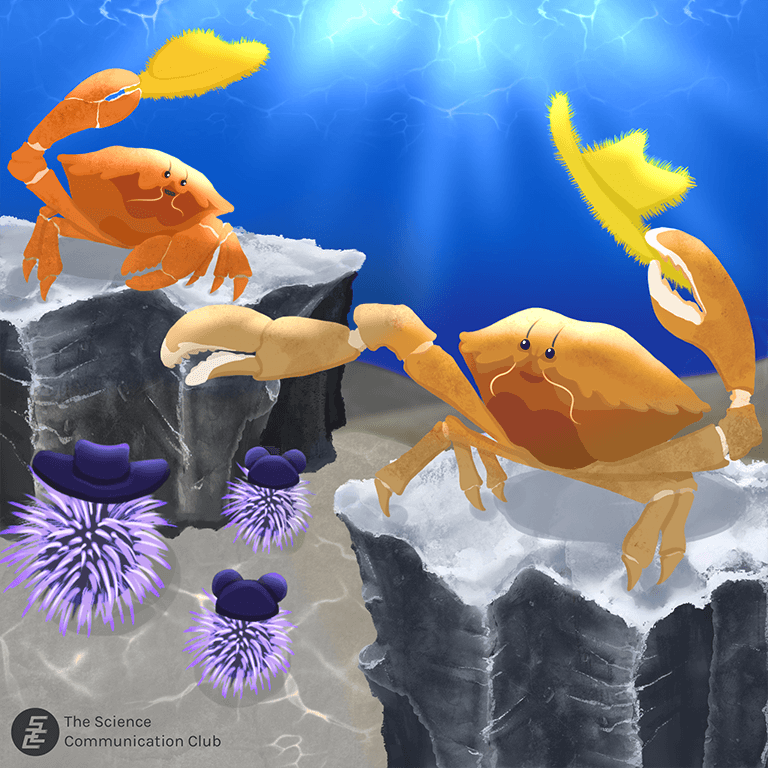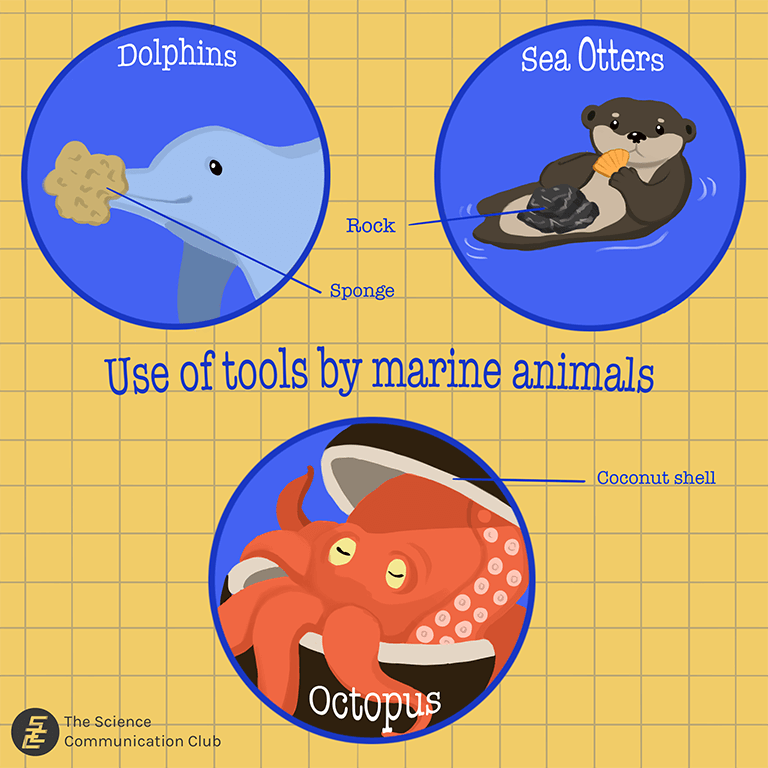
Written by Alejandro Izquierdo Lopez
Illustrated by Juliet Ko
In 2011, researchers came across something puzzling on 3.4-million-year-old fossilized bones: cut marks. Someone had cleaned and cut these bones—possibly using a pointy stone! The culprit? A member of Australopithecus afarensis, Lucy’s species. This is one of the first reported cases of tool-use in our ‘human’ family, and, since then, our history has been tied to the use and development of tools, up to this day. This, however, is not a defining trait of mankind: many animals were using tools long before us and still continue to do so. You have probably seen videos of chimpanzees using long branches to get termites out of their nests, or even crows twisting sticks to extract insects out of their hiding places. However, you may not be familiar with what’s happening under the sea: crabs wearing hats, sea-urchins carrying stones, dolphins covering themselves with sponges… Marine animals also have toolboxes, which have gone, for the most part, unnoticed.
Strategy 1: protect yourself!
At sea, the easiest strategy to avoid a predator is to out-swim them. But what happens if you are a slow animal, like a crab? You need to search for a place to hide in order to survive. The sea-depths are very different from a forest or a jungle, and without a coral reef or a rocky platform, it is quite difficult to remain undercover. In response, certain groups of crabs have devised a solution; they have learnt to use objects in their environment as disguises. Sponge crabs, for example, cut up pieces of sponges and place them on top of their head, like a hat. We know that this is certainly a disguise, as crabs always use the most common species of sponge in their surroundings to blend in. They are indeed masters of disguise, and have even evolved specialized, tiny, Velcro-like hairs to hold the objects that they put on top of their head and legs. Other crabs use sea-anemones as hats: with their stinging tentacles, the sea anemone does not work as a disguise, but rather, as an active defence mechanism against predators.
Crabs are not the only ones to use tools as defence. The spines of a sea-urchin are a frightening sight to any swimmer, but the reality is that those spines can break quite easily. Every time a wave drags in a sea-urchin, there is a chance that the animal will crash into a rock or be carried through abrasive sand, damaging the spines in the process. Sea-urchins cannot withstand this harm, as the creation of new spines requires a lot of energy. But, they too, have found a solution: more hats! Between their spines, sea-urchins actually have elongated, small, tube-like feet, which they use to move around and hold objects. With their feet, they gather stones and other hard objects and use them as shields. Octopi use a similar strategy but take it one step further: they create huts. In sandy areas, frequently barren, octopi can feel quite unprotected when encountering predators. Sometimes, though, they find a very useful object: a coconut shell. They carry the coconuts with them and use them as shields or even as an improvised hut against predators—literally enclosing themselves between the shells.

Strategy 2: use a tool to get more food!
Tools are not only used for defence, but also to attack. Sea otters, for instance, have learnt that the best way to access the juicy contents of a barnacle or a clam is to break them open with a rock. These animals gather rocks inside skin-pouches close to their arms, and once they locate a clam, they swim to the surface and lay there upside-down. Then, using the stones as a hammer and their chest as an anvil, they break into the clam.
Other animals use tools in a combination of attack and defence. A specific population of dolphins from Shark Bay Australia is of great interest to scientists researching animal behaviour. There, dolphins have invented many predatory strategies—a diversity of behaviours which rivals that of chimpanzees. The strategy known as “sponging” is one of many, where dolphins break sponges and attach them to their mouths. With this new sponge-complement, they can search for sand-buried prey without the risk of having their mouth damaged by the sand, or by the preys themselves.
One interesting fact about “sponging” is that this behaviour is more common in females than males. Is this a tradition passed down across females? Or, is there perhaps a genetic component to it? Likewise, it’s clear that sea-urchins aren’t taught how to use stones, and even sea otters seem to know what to do when presented with a clam and a stone, without anyone teaching them. This brings about interesting questions regarding intelligence and the nature of learning. It’s possible that not all learning is acquired externally—with some behaviours being actually coded into our genome. Scientists are still debating these questions and use certain populations, such as the Shark Bay dolphins, to understand how learning is both originated and transmitted.
Are there other tool-using animals in the ocean, waiting to be discovered? Theoretically, using tools under water is more complicated than on land: there are fewer materials to work with, and the objects tend to be lighter—making them, overall, less effective and more difficult to handle. Consequently, we expect oceanic tool users to be quite uncommon. However, we still know very little about the ocean’s inhabitants, and among the thousands of species that are yet to be discovered, there are probably still many surprises left to uncover.
Sources:
- McPherron, S. P., Alemseged, Z., Marean, C. W., Wynn, J. G., Reed, D., Geraads, D., … & Béarat, H. A. (2010). Evidence for stone-tool-assisted consumption of animal tissues before 3.39 million years ago at Dikika, Ethiopia. Nature, 466(7308), 857-860.
- St Clair, J. J., & Rutz, C. (2013). New Caledonian crows attend to multiple functional properties of complex tools. Philosophical Transactions of the Royal Society B: Biological Sciences, 368(1630), 20120415.
- Guinot, D., Doumenc, D., & Chintiroglou, C. C. (1995). A review of the carrying behaviour in brachyuran crabs, with additional information on the symbioses with sea anemones. Raffles Bulletin of Zoology, 43, 377-416.
- Dumont, C. P., Drolet, D., Deschênes, I., & Himmelman, J. H. (2007). Multiple factors explain the covering behaviour in the green sea urchin, Strongylocentrotus droebachiensis. Animal Behaviour, 73(6), 979-986.
- Bell, J. J. (2008). The functional roles of marine sponges. Estuarine, Coastal and Shelf Science, 79(3), 341-353.
- Mann, J., & Patterson, E. M. (2013). Tool use by aquatic animals. Philosophical Transactions of the Royal Society B: Biological Sciences, 368(1630), 20120424.